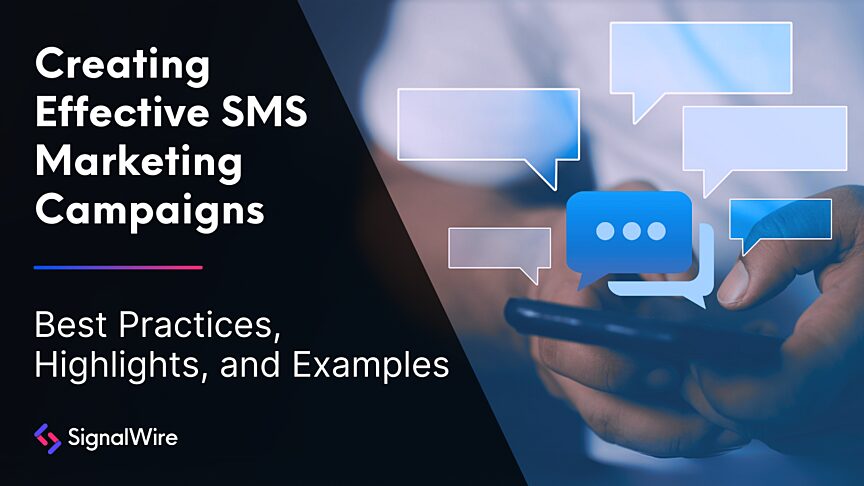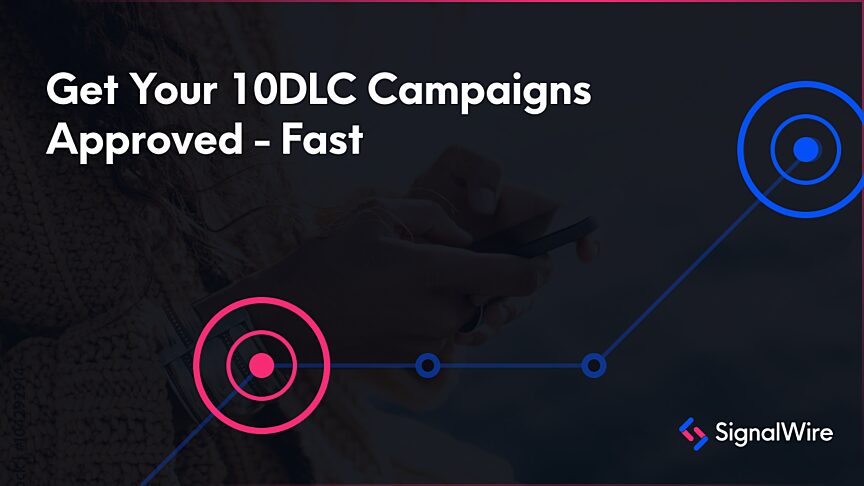Managing A2P 10DLC messaging campaigns can be overwhelming, with various steps, regulations, and evolving technologies to consider. Fortunately, SignalWire offers a structured approach to help you navigate these challenges. In our recent LiveWire webinar, we discussed how to successfully navigate the world of messaging campaigns with our carrier operations experts.
Key Considerations for 10DLC Messaging Campaigns
Messaging campaigns serve various purposes, from generating sales leads and sending one-time passwords to providing order updates or promotional materials. Whether you're reaching out for marketing purposes or sending transactional messages, defining your audience and goals will shape how you design your content and set the frequency of your messages.
Once you have defined the purpose of your campaign, setting the right cadence for sending messages is an important consideration. For example, order updates should be sent as they happen, but marketing messages must be carefully paced (we usually advise no more than once a week) to avoid overwhelming your audience.
You must also create clear, concise content that includes your brand name and adheres to any regulatory guidelines, including opt-in and opt-out rules. If this part seems overwhelming, don’t worry–this is where SignalWire can help.
The Role of The Campaign Registry
When it comes to regulatory guidelines, the main factor to consider is that you’ll have to register your A2P 10DLC messaging campaigns with The Campaign Registry (TCR), an industry-led organization that manages campaigns to reduce spam. Working with SignalWire allows you to navigate any obstacles when registering messaging campaigns with TCR.
At SignalWire, we make sure that campaigns meet all necessary requirements and remain compliant so that you can get registered the first time. Registering correctly with TCR improves message delivery and prevents higher carrier fees that come with unregistered messaging.
When registering a campaign, several details must be provided, including your company’s legal name, tax ID, and use case (whether the campaign is marketing-related, transactional, or otherwise). Sample messages and descriptions of your opt-in and opt-out processes are also required.
Once these details are submitted, the campaign is reviewed to check that it meets compliance standards. This process helps prevent issues such as spam and provides benefits to the sender like better message throughput.
Challenges in Managing Messaging Campaigns
Managing messaging campaigns can be complicated due to a multitude of factors at play. Different messaging platforms—such as SMS, MMS, WhatsApp, and Telegram—each come with their own sets of features and limitations and create potential compatibility issues.
Additionally, businesses that operate in multiple countries must navigate a web of privacy laws and spam regulations, which vary by region. As if that weren’t enough, controlling spam and malicious content remains a significant challenge, with bad actors constantly finding new ways to exploit the system.
SignalWire addresses these complexities through a combination of robust technology, proactive strategies, and close collaboration with industry bodies like TCR. By staying aligned with industry standards, SignalWire helps businesses anticipate changes and adapt before new regulations are enforced.
Our dedicated team members also provide ongoing guidance, helping companies avoid blocks in their campaign registration and reducing the risk of non-compliance. Our flexible APIs simplify this process, allowing you to adapt quickly to any new requirements without having to overhaul their entire messaging infrastructure.
Common Mistakes and How to Avoid Them
Many common mistakes can slow down or disrupt your messaging campaign. Some of these mistakes include:
Incomplete Information: Missing or inaccurate details can lead to rejection or delays.
Ignoring Compliance: Not adhering to opt-in and opt-out requirements or data privacy laws can halt the approval process.
Delayed Responses: Failing to respond promptly to requests for additional information can extend registration time.
Failing to comply with carrier-specific guidelines can cause significant roadblocks. It's also essential to choose the correct use case when registering your campaign. If you mistakenly register under the wrong category, you’ll need to start the process from scratch, as changing the use case after submission is not allowed.
After your campaign is live, we encourage you to continuously monitor its performance. Spam blocks are a frequent issue, particularly for messages that seem overly promotional or are sent in large volumes without proper pacing.
If your campaign has a high opt-out rate, meaning more than 5% of recipients are asking to stop receiving your messages, this is a signal to carriers that the content may not be well-received. Such red flags can lead to your campaign being flagged as spam or even suspended.
Additionally, make sure that the content of your live messages aligns with what you registered. If your messages deviate significantly, you risk having your campaign blocked.
Choosing SignalWire as Your Messaging Partner
Whether you're handling just a few campaigns or thousands, SignalWire is a trusted partner for messaging. With our expertise in managing campaign registrations and a history of remaining at the forefront of industry regulations, you can focus on delivering effective communications, while we handle the intricacies of keeping your campaigns compliant.
By leveraging SignalWire’s comprehensive support and proactive industry partnerships, you can ensure that your messaging campaigns comply with regulatory requirements and deliver meaningful results. Get started today by testing out our platform free trial.
Have questions? We have answers! Check out our extensive TCR FAQ, add us on Slack, or ask us on our Community Forum.


